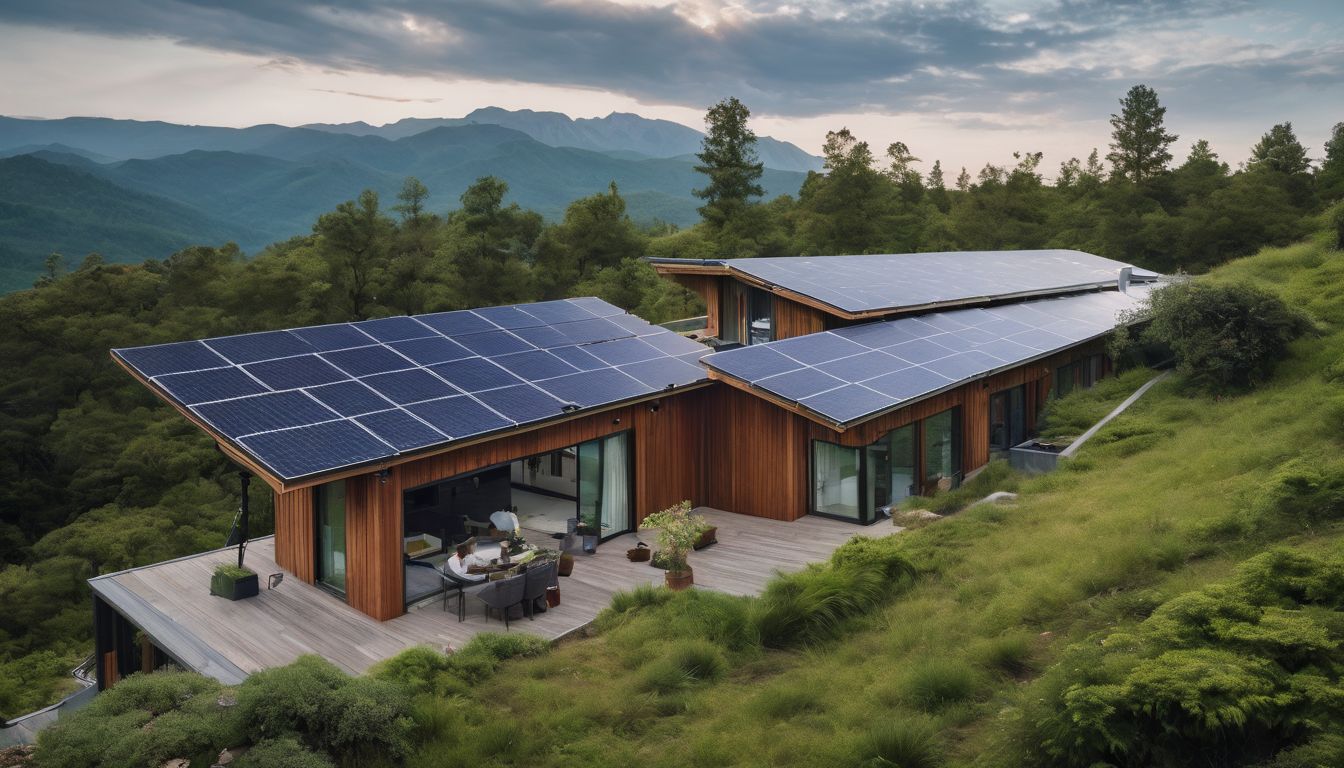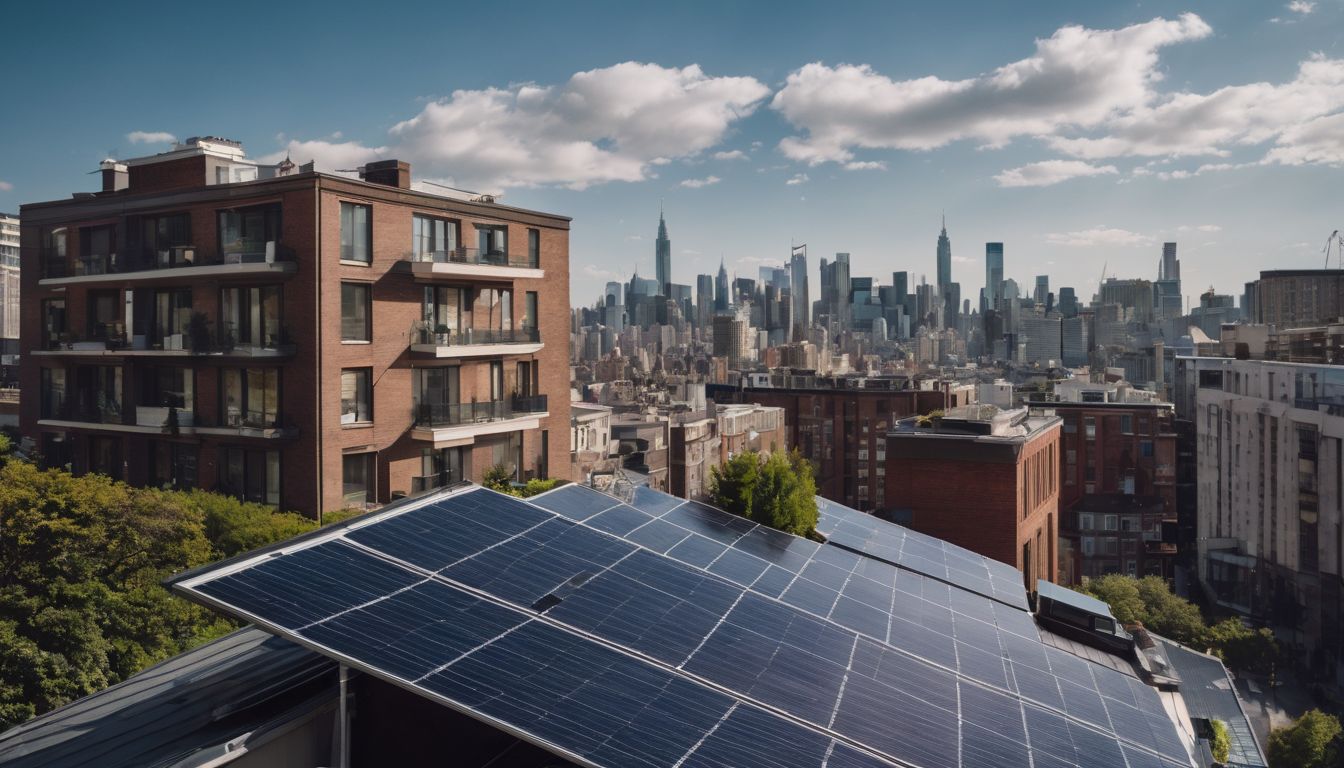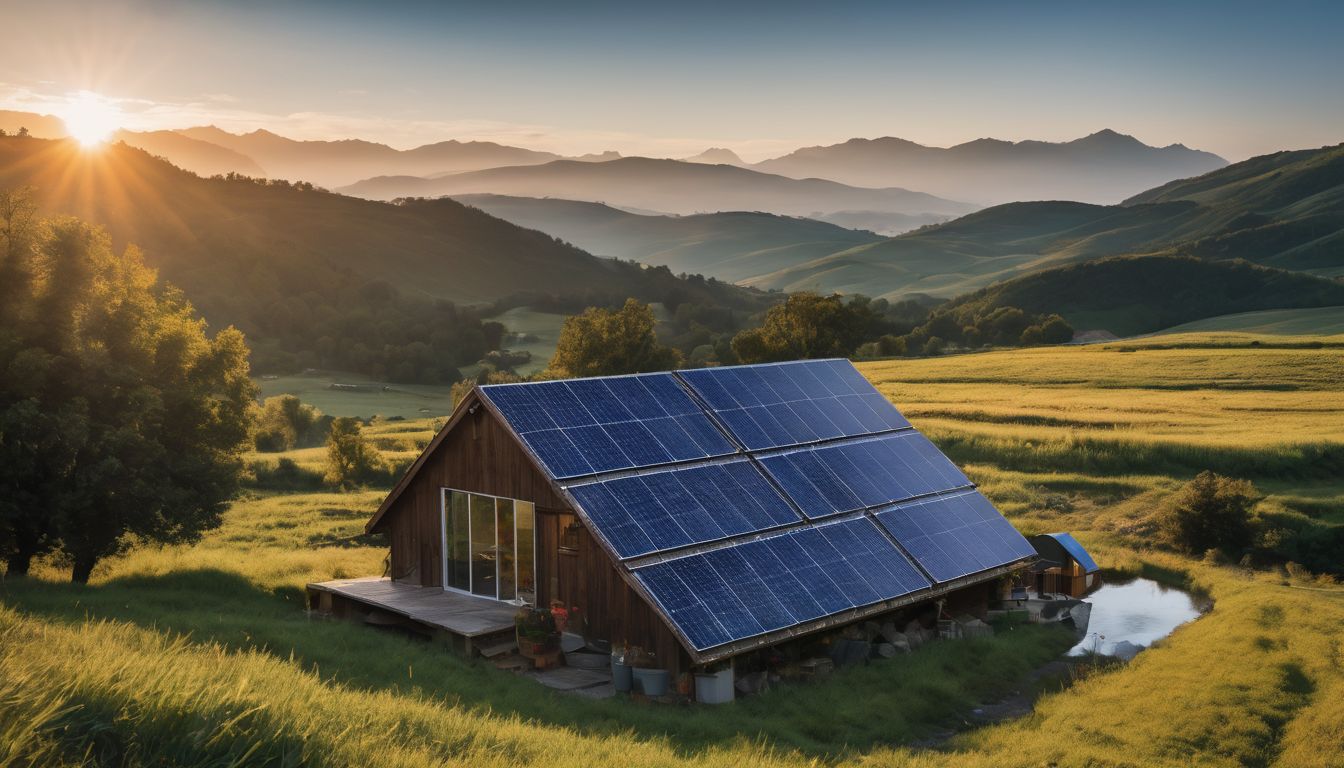Harnessing the sun’s power efficiently is a puzzle we’re all trying to solve. Did you know that solar trackers can boost energy production by up to 30%? Our blog delves into the latest solar tracking technology, helping you understand how it maximises your clean energy gains.
Let’s make every ray count!
Key Takeaways
- Solar trackers can increase a solar panel system’s energy production by up to 30%, with dual-axis trackers potentially boosting it by up to 45%.
- Types of solar trackers include manual, passive, and active systems, each with its own mechanisms for optimal sun tracking and varying levels of efficiency gains.
- AI-driven tracking systems use machine learning to adjust panels based on real-time sunlight and weather data for maximum efficiency.
- Airlink technology allows multiple solar trackers to communicate wirelessly, ensuring coordinated movements for improved energy capture.
- Proper installation and regular maintenance are critical for the performance of solar tracking systems; this includes cleaning panels, checking connections, lubricating moving parts, monitoring performance regularly, making seasonal adjustments, and scheduling professional maintenance checks.
What are Solar Trackers and How Do They Work?
One of the key components of solar panel technology is the solar tracker, which helps to direct the panels towards the sun for optimal energy capture. There are different types of solar trackers, including manual, passive, and active systems, each with its own unique benefits and components.
Types of solar trackers (manual, passive, active)
Solar trackers are devices that move solar panels to follow the sun across the sky. These tracker systems maximise energy capture by keeping panels optimally oriented towards the sun throughout the day.
- Manual Solar Trackers involve adjustments by hand to align panels with the sun’s position. Installers set these trackers at specific angles at different times of the year, but these require frequent manual readjustments to be effective.
- Passive Solar Trackers use a low boiling point compressed gas fluid that moves from one side of the tracker to another as it heats up, tilting the panel towards the sun. They rely on heat differences throughout the day for movement and do not need electricity or motors to operate.
- Active Solar Trackers utilise motors and gears controlled by a programmable logic controller (PLC) that responds to the sun’s movement. Sensors direct motors to adjust PV panel orientation accurately, ensuring maximum solar energy capture through precise tracking.
Components of a solar tracker
Exploring the Different Types of Solar Tracking Systems provides insights into the different mechanisms and functionalities. For environmentally conscious individuals, understanding the components of a solar tracker is crucial for comprehending how these systems operate effectively.
- The main components include sensors to detect sunlight, a control unit, motors to drive movement, and a mounting structure for attaching solar panels.
- Sensors are essential for tracking the sun’s position and adjusting the angles of the solar panels.
- The control unit processes data from sensors and calculates the ideal position for maximum energy capture.
- Motors are responsible for adjusting the orientation of the solar panels according to the instructions received from the control unit.
- The mounting structure securely holds the solar panels and allows for smooth movement as they track the sun’s trajectory throughout the day.
Benefits of solar tracking systems
Solar tracking systems offer increased energy production compared to fixed solar panels. By adjusting the position of the panels throughout the day, they can capture more sunlight and convert it into electricity.
This enhanced efficiency leads to higher energy output, making solar tracking systems an appealing option for those seeking maximum renewable energy generation.
In addition, solar tracking systems help reduce the overall cost per watt of electricity generated over time, providing a better return on investment for environmentally conscious individuals looking to support conservation efforts.
Exploring the Different Types of Solar Tracking Systems
There are different types of solar tracking systems, including single-axis and dual-axis trackers. Each type has its own pros and cons, and it’s important to understand the differences in order to make the best choice for your solar energy system.
Single-axis vs dual-axis trackers
In the quest for efficiency, solar trackers have revolutionised the way we harness the sun’s energy. Here’s how single-axis and dual-axis trackers stack up against each other.
| Feature | Single-axis Trackers | Dual-axis Trackers |
|---|---|---|
| Movement | Follow the sun east to west | Track the sun in all directions |
| Complexity | Simpler mechanics | More complex systems |
| Installation | Easier and less costly | More involved, higher initial cost |
| Efficiency Gain | Increases output by up to 25% | Boosts energy production by up to 35% |
| Maintenance | Less maintenance required | Higher maintenance due to complexity |
| Space Requirements | Less space between rows needed | More space necessary to avoid shading |
| Ideal Use | Large-scale utility projects | Locations with high solar potential |
Pros and cons of each type
- Pros:
- Follow the sun’s path from east to west, increasing energy output by around 25%.
- Less complex and costly compared to dual – axis trackers.
- Cons:
- Limited to horizontal movement and cannot adjust for seasonal changes in the sun’s elevation.
- Pros:
- Track the sun’s movement both horizontally and vertically, maximising energy production by up to 45%.
- Ideal for locations with high latitudes or areas with variable weather conditions.
- Cons:
- Require more components and maintenance, resulting in higher initial costs and potential for increased downtime.
Enhancing Energy Capture and Efficiency for Installers
Improving energy capture and efficiency is crucial for installers when selecting a solar tracking system. Understanding the impact of tracking on solar energy output and considering factors such as location and weather conditions are essential for maximising the benefits of solar trackers.
Impact of tracking on solar energy output
Solar tracking systems significantly enhance solar energy output. By constantly adjusting the orientation of solar panels to follow the sun’s path, these systems can improve energy capture by up to 25%, maximising overall efficiency.
Single-axis trackers adjust panels along one axis, while dual-axis trackers adapt them both horizontally and vertically. This continual alignment ensures that panels receive optimal sunlight, increasing electricity generation and boosting the overall performance of solar power installations.
Factors such as location, weather patterns, and project size play a crucial role in selecting the right tracking system for maximising energy output. The choice between single-axis and dual-axis trackers depends on specific project requirements, making it essential for installers to carefully consider their options before implementing a solar tracking system.
Factors to consider when selecting a solar tracking system
When selecting a solar tracking system, consider the location of your solar panels and the angle of sunlight. Assess the available space and required capacity for power generation. Evaluate the cost and maintenance requirements for different types of solar trackers. Also, think about the environmental impact and energy efficiency of the system. Take into account the durability and reliability of the tracking technology. Consider the potential for future upgrades or expansion options. Compare the performance data and user reviews of different solar tracking systems. Consider the compatibility with existing photovoltaic installations if applicable.
Advanced Solar Tracking Technologies
Advanced solar tracking technologies such as AI-driven systems and the use of airlink technology are pushing the boundaries of efficiency and energy capture in solar tracking. These cutting-edge advancements are revolutionising the industry and paving the way for even greater sustainability in solar energy production.
AI-driven tracking systems
Innovative AI-driven tracking systems use advanced algorithms to constantly monitor the sun’s position and adjust solar panels for optimal energy capture. These intelligent systems can predict changes in weather patterns, allowing solar panels to adapt and maximise efficiency.
By harnessing the power of artificial intelligence, these cutting-edge tracking systems contribute to sustainable energy solutions while reducing environmental impact.
AI-driven tracking systems revolutionise solar technology by integrating real-time data analysis and machine learning, ensuring maximum energy output from solar installations. As a result, these high-tech solutions offer environmentally conscious individuals the opportunity to make a significant impact on conservation efforts while embracing renewable energy sources.
Use of airlink technology
Continuing with innovative solar tracking technologies, airlink technology is revolutionising the industry. This cutting-edge system uses wireless communication to link multiple trackers together, enabling real-time data exchange and synchronisation.
The use of airlink technology ensures seamless coordination between solar panels, maximising energy capture and improving overall system efficiency. By leveraging this advanced approach, installers can optimise solar tracker performance and deliver enhanced energy output to environmentally conscious consumers.
Employing airlink technology in solar tracking systems facilitates continuous communication among trackers, allowing for precise adjustments based on environmental conditions while minimising downtime and maintenance needs.
Installation and Maintenance Best Practices
To ensure maximum efficiency, proper installation of solar tracking systems is essential. Regular maintenance and monitoring are also important for optimising the performance of solar trackers.
Ensuring proper installation
To ensure proper installation of solar tracking systems, consider the following best practices:
- Assess the site: Select an unobstructed location with no shading from trees or buildings to maximise sun exposure.
- Foundation preparation: Ensure a stable and level foundation for the solar tracker to prevent tilting or misalignment.
- Correct orientation: Position the tracker facing true south in the Northern Hemisphere and true north in the Southern Hemisphere for optimal solar energy capture.
- Secure mounting: Use high-quality, weather-resistant materials and secure fastenings to withstand environmental conditions and prevent damage.
- Wiring and connections: Follow manufacturer guidelines for proper wiring and connections to avoid electrical issues.
- Regular inspections: Schedule routine visual checks and maintenance to detect any issues promptly and ensure efficient operation.
Tips for maintaining and optimising solar trackers
- Regular Cleaning: Clean the solar panels from dust, debris, and bird droppings to ensure maximum sunlight absorption.
- Inspect Connections: Regularly check for loose or corroded connections in the tracking system to prevent energy loss.
- Lubrication: Ensure that all moving parts are properly lubricated to prevent wear and tear.
- Monitor Performance: Use monitoring software to track the efficiency of your solar trackers and identify any issues promptly.
- Seasonal Adjustments: Make adjustments to the tracker angles according to seasonal changes in sun position for optimal performance.
- Professional Maintenance: Schedule regular maintenance checks by a certified technician to keep your solar tracking system running smoothly.
Conclusion
Innovations in solar tracking technology are enhancing energy capture and efficiency for installers. AI-driven tracking systems and the use of airlink technology are advancing the capabilities of solar trackers.
Ensuring proper installation and implementing maintenance best practices will further optimise solar tracker performance. With these advancements, environmentally conscious individuals can make a greater impact on conservation by harnessing the power of solar energy.
FAQs
1. What is a solar tracker system?
A solar tracker system adjusts the position of your solar panels to follow the sun’s movement, increasing efficiency and energy output.
2. What’s the difference between dual axis and single axis tracking?
Dual axis tracking moves in two directions for optimal sun exposure while single axis tracking tilts along one plane, usually either horizontally or vertically.
3. How does a sun tracking system improve solar panel performance?
Sun tracking systems help orient your solar array towards the sun throughout the day, which can significantly boost their power generation capacity.
4. Are modern solar tracking systems expensive to install?
The price of installing a modern solar tracking system varies but tends to be higher than fixed installations due to additional components and technology involved.
5. Can adding a solar tracker make my existing panels more efficient?
Yes! Retrofitting trackers could potentially enhance how much electricity your current setup produces by optimising panel orientation regarding the sun’s path.




